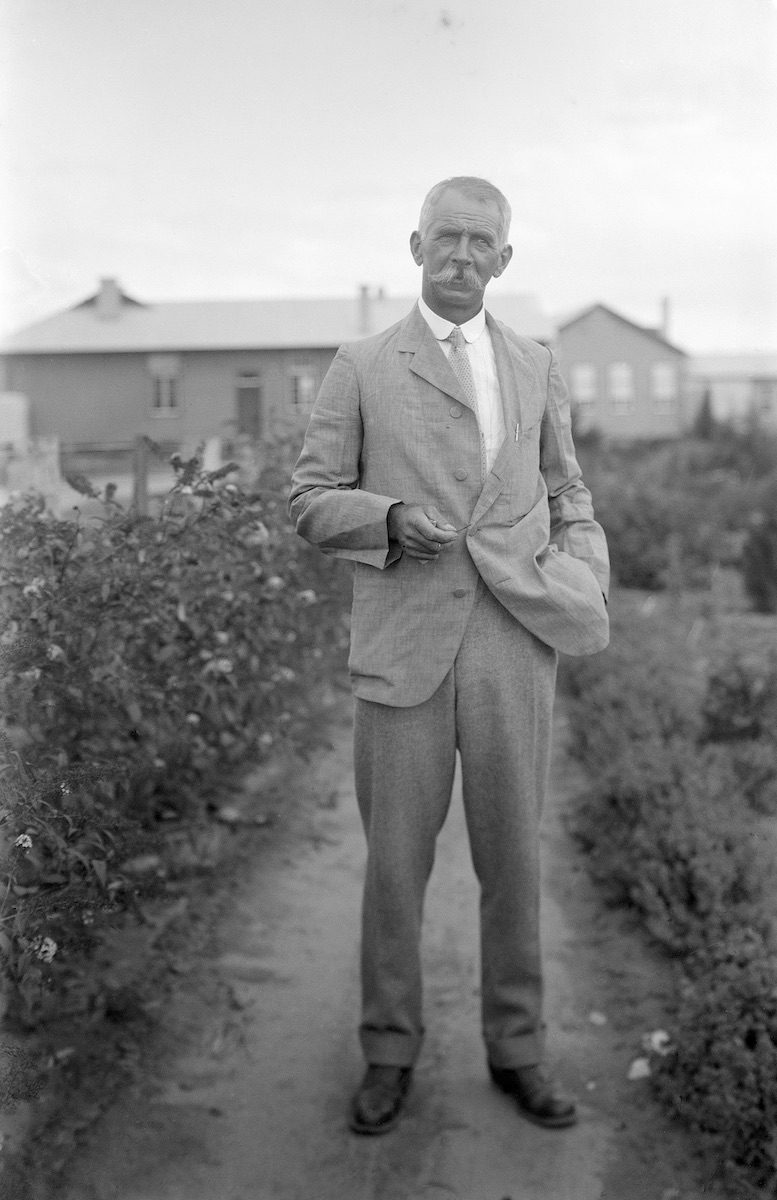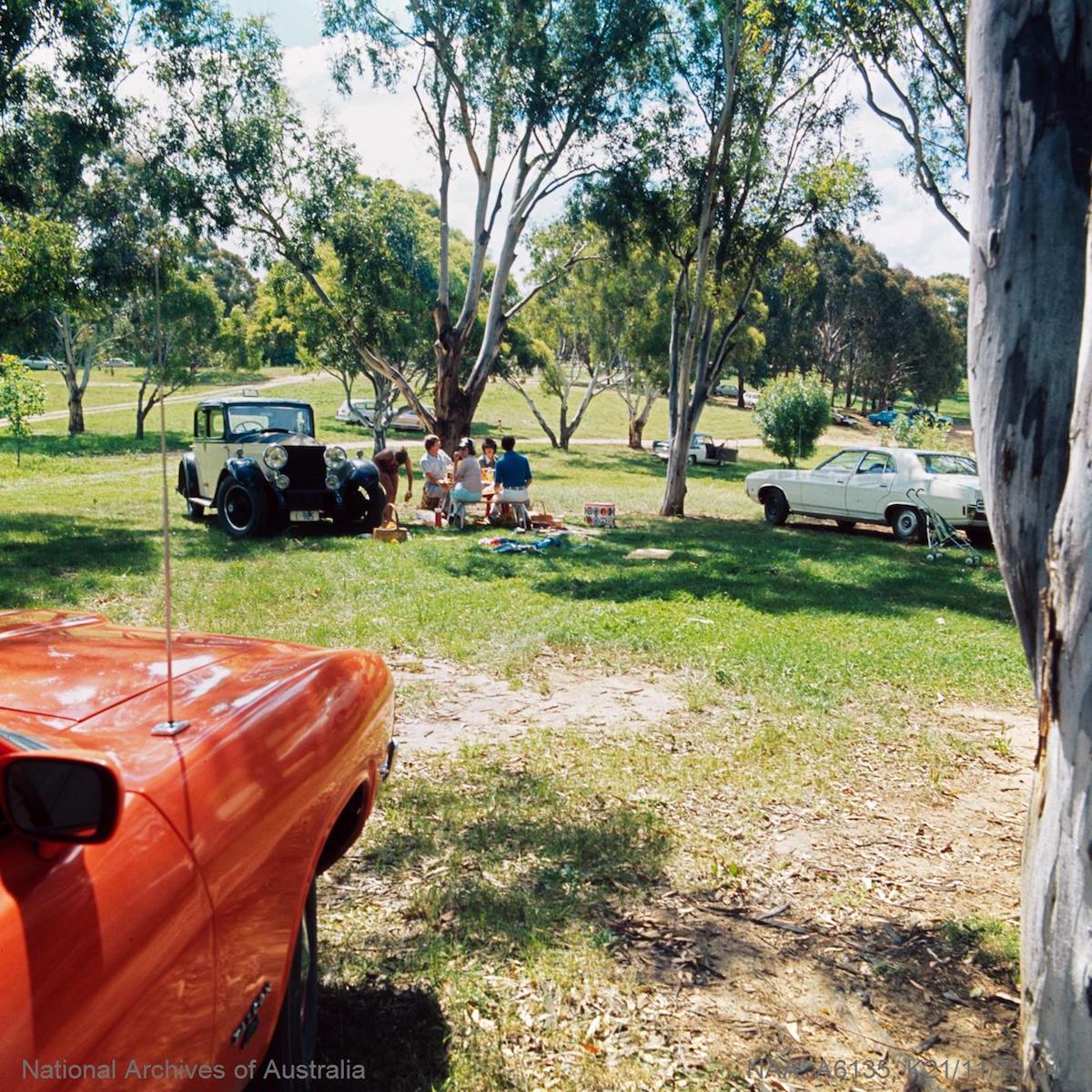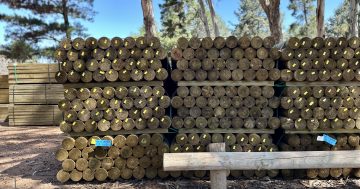
Charles Weston at Yarralumla Nursery in the 1920s. Photo: National Archives of Australia (A3560, 233).
When the site for the new capital city was selected in 1908, this area was known as the Limestone Plains. It was largely a bare, windswept plain.
Walter Burley Griffin, Canberra’s architect, was influenced by the City Beautiful and Garden City movements of the late 19th and early 20th centuries. He planned a garden city, including an arboretum and botanical reserves. This would transform that windswept plain.
Griffin proposed the city have its own natural colour. He envisaged the city’s hills to have distinct colour differences. Mount Ainslie was to be yellow with wattles and broom, Black Mountain to be covered with pink and white flowering fruit trees, Red Hill to live up to its name with the flowering scarlet bottlebrush Callistemon Lanceolatus, and Mount Mugga Mugga to have a blue-grey tone. This plan didn’t fully come to pass, but today you can see a red Callistemon plantation on Red Hill and the blue-grey tones on Mount Mugga.
T.C.G. (Charles) Weston was appointed Officer in Charge of Afforestation in 1913. His job was to experiment with trees and plants that would suit the harsh climate of the new capital, improve its tree cover and develop Griffin’s garden city principles. He was also tasked with developing a forestry industry.
Weston established Westbourne Woods, a nursery and arboretum at Yarralumla. It was a site of good soil quality with access to water. Planting began in 1914.
Weston noted that conifers and some exotic species grew well locally so began his scientific research on that basis. He was an advocate for both native and exotic species, propagating and growing both, and he established a large seed collection. Australian native trees, exotic hardwoods and over 200 different species of conifers were planted during the war years. By 1920, Westbourne Woods had grown to contain around 45,000 trees, and by the 1980s it was the oldest collection of tree species in the country outside designated botanical gardens.
Weston was responsible for planting windbreaks and entrance borders. His work also included creating a hybrid eucalypt species. Evidence of Weston’s plantings can be seen in Canberra’s older suburbs – he experimented with planting one variety of tree to line each street. This has created a diverse patchwork of colour to be enjoyed throughout these suburbs, especially in spring and autumn.
By 1945, the area was suffering a severe drought. Keeping Westbourne Woods watered and maintained as well as controlling recreational use was becoming a challenge. In 1949, a solution to this was to clear some of Westbourne Wood’s trees, establish fairways and create the greens for the Royal Canberra Golf Club. The future lake would be a water source for the arboretum and golf course. Royal Canberra Golf Club took over the lease of the area in 1960. The Commonwealth remained responsible for long-term management, and ANU forestry students were provided access.
Yarralumla Nursery was used by the Parks and Gardens research department until the 1970s. Over the last 100 years, the nursery has grown around 50 million plants and continues today producing around 400,000 plants each year.
Since 1930, Canberra households could claim a free allocation of plants from Yarralumla Nursery to help establish their new gardens – to create the garden city Walter Burley Griffin envisaged. This free plant issue is still available today for new residential blocks of land.
Nearby Yarralumla Nursery is Weston Park, named after Charles Weston. This park, enjoyed by many for its recreation facilities, also contains plantings by Weston.

Nearby Yarralumla Nursery is Weston Park, named after Charles Weston. This park, enjoyed by many for its recreation facilities, also contains plantings by Weston. Pictured here in 1973. Photo: National Archives of Australia (A6135, K21/11/73/24).
Friends of the ACT Trees (FACTT) is a group interested in Canberra’s trees and landscape and works to raise awareness of the beauty and historical significance of Westbourne Woods. You can be part of a free guided walk, conducted by FACTT on the second Sunday of each month at 9:30 am. The tour begins at the gates of Royal Canberra Golf Club and the walks last about two hours. If you’d like to visit Westbourne Woods privately, call in to the clubhouse as a courtesy first to inform them.
Throughout Westbourne Woods, you will find beautiful species including the northern hemisphere’s Scott’s pine, found in Scotland, Scandinavia, northern Russia and Siberia; the English oak; Californian giant sequoia; and the tall Douglas fir or Oregon pine, the same type of timber used for the Canadian flagpole that stood on Regatta Point for many years.
Just inside the gate of the club are some stone pines, which produce edible seeds. If you go through Westbourne Woods with a guide, make sure to ask about the Chilean soap tree, a particular favourite of mine.
When the Provisional Parliament House opened in 1927, an instant garden in front was created with 12-year-old cedar trees grown by Charles Weston. After Weston’s death in 1935, his ashes were scattered among those trees.
Original Article published by Marg Wade on Riotact.



